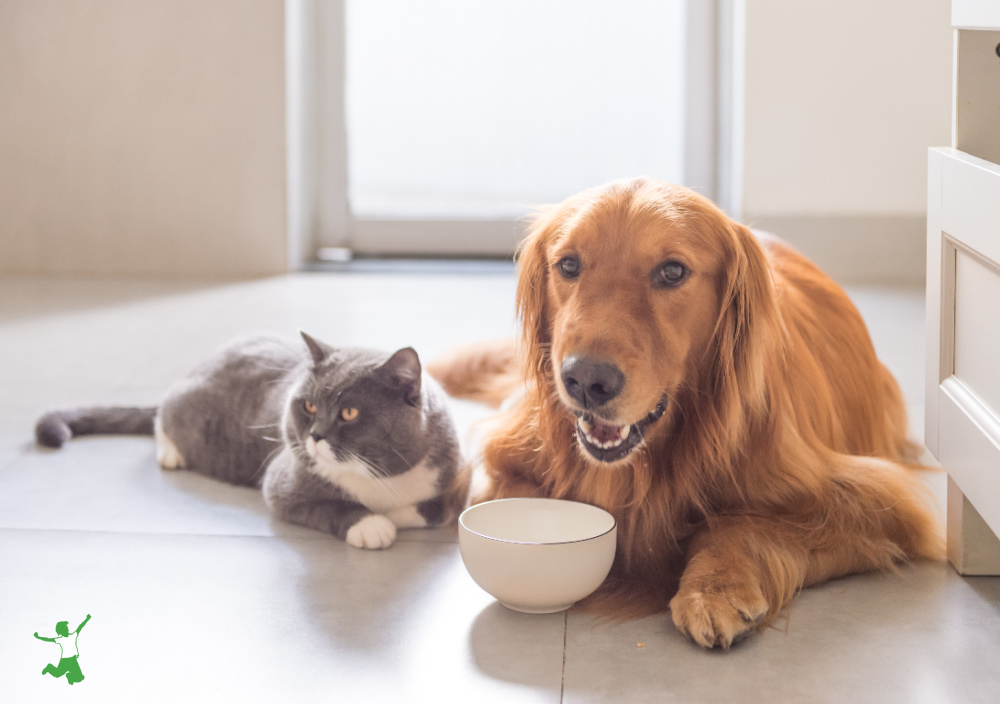Table of Contents[Hide][Show]
- Cats Are Obligate Carnivores
- Dogs Are Gray Wolves on the Inside
- Characteristics of Carnivorous Canines and Felines
- Very Sharp Teeth
- Premolars and Molars are “Carnassials”
- Jaws That Move Exclusively Vertically
- Extremely Strong Stomach Acids
- Short Digestive Tracts
- Rapid Digestive Transit Time
- Other Unique Carnivore Traits
- Summary
The ideal traditional diet for domesticated cats and dogs and how their physiological characteristics easily identify the type of food that keeps them healthy and disease-free.

As we consider what sort of diet to feed our furry domesticated animal companions, it’s vital that we understand their innate anatomical and physiological characteristics.
It’s these qualities that determine, to a very great extent, the kind of food their bodies were naturally designed to eat by Mother Nature.
Feeding our pets a species-appropriate diet, which is based on the kind of raw, animal-based food their bodies are designed to consume, provides our pet cats and dogs with the best opportunity to thrive, enabling them to live the longest, healthiest lives possible.
Cats Are Obligate Carnivores
There’s absolutely no doubt whatsoever, scientifically speaking, that all felines on the planet – whether they be huge cats like lions and tigers, or smaller ones such as ocelots, servals and yes, domestic house cats — are what are known as obligate carnivores.
Obligate carnivores are “true carnivores,” meaning these animals’ bodies are specifically designed to consume the flesh and bones of other animals.
Such carnivores are virtually solely dependent upon the nutrients found in animal-based foods, which they absolutely require to maintain good health.
Felines are among the most successful predatory animals on the planet, and their anatomy and physiology are very clearly those of a hunter.
As such, cats have virtually no need for plant-based food or carbohydrates, although they may consume small amounts of plant-based materials occasionally, usually as a medicinal to induce vomiting.
In fact, they have so little use for dietary vegetative matter that their digestive systems actually lack the physiological ability to effectively process or assimilate any plant-based foods whatsoever.
Please bear this in mind the next time you look at the ingredients list on a bag of commercial kibble and see things like soy, corn, rice, wheat, or other plant-based items like legumes or vegetables on the label!
Dogs Are Gray Wolves on the Inside
Regardless of variations in their size, coat texture, ear shape and/or other superficial, external differences, all breeds of domestic dogs are members of the same species, and are known as Canis lupus familiaris.
All domesticated dogs are direct descendants and are also technically a subspecies of the gray wolf, Canis lupus.
As a result, internally, in terms of their dentition as well as their internal digestive anatomy and physiology, dogs are essentially identical to gray wolves.
Both dogs and wolves are members of the Canidae family of the mammalian order Carnivora, which means they are meat eaters, or carnivores.
Gray wolves are predatory animals whose primary preferred prey are large ungulates such as deer, elk, caribou and other large herbivorous creatures.
However, since they’re not obligate carnivores like cats, gray wolves, along with their domestic canine counterparts, are opportunistic carnivores.
This means that when large game is unavailable, they have the ability to survive by consuming a small amount of plant matter.
However, it’s important to understand that doing so is an emergency survival mechanism, and that these animals’ bodies were truly designed to thrive on the consumption of the raw meat, bones and organs of herbivorous prey-type animals, most particularly those of large grazers.
Characteristics of Carnivorous Canines and Felines
There are a number of anatomical and physiological qualities that are shared by all mammalian carnivores, including domestic cats and dogs.
Familiarizing ourselves with these characteristics can help us better understand the reasons why it’s so important to feed our pets a diet consisting of whole, raw, animal-based foods.
These are the sorts of foods their bodies were truly designed many millions of years ago to consume, and it is upon such a diet that they best thrive.
Below is a list of some of the most important and relevant carnivorous characteristics common to both cats and dogs.
Very Sharp Teeth
Carnivores can easily be identified by their teeth.
They are very sharp and designed for grasping, ripping, and tearing raw flesh and crushing raw meaty bones.
Premolars and Molars are “Carnassials”
The uppers and lowers of which come together when the jaw closes like the sharp blades of a pair of scissors.
This mode of operation is the most effective angle for tearing, shearing, slicing, and cutting raw food into pieces that are just small enough to fit down the animal’s throat.
Jaws That Move Exclusively Vertically
This vertical-only movement of the jaw includes the lower jaw that is utterly incapable of moving side to side.
This is quite unlike the lower jaw of an herbivore such as a cow or sheep, which moves side to side horizontally, contains large, flat molars, and is made for lengthy and often repeated chewing and grinding of plant matter.
Omnivores also have jaws that can move side-to-side. Combined with a few canine teeth, it is a clear physiological demonstration that humans are ideally designed to eat plants as well as animal foods!
Extremely Strong Stomach Acids
The stomach acids of a carnivore are more powerful than herbivores or omnivores.
These acids are designed to quickly and effectively neutralize any potentially harmful bacteria or parasites that might be found on raw meat.
They can even dissolve bone!
Short Digestive Tracts
The shortness of the carnivore digestive tract is due to the ease with which meat can be digested compared to plant matter.
Only a short digestive tract is required to quickly and efficiently extract the concentrated nourishment found in animal-based foods.
This compares to the multiple stomach compartments (rumen, reticulum, omasum, and abomasum) in herbivores, each playing a specific role in digesting tough plant materials like grass.
Rapid Digestive Transit Time
The rapid digestive transit time for carnivores minimizes the amount of time microbe-laden raw meat remains in the body.
This reduces the chance of any potentially harmful bacterial colonization.
Other Unique Carnivore Traits
Some other traits shared by dogs and cats that earmark them as carnivores are their keen senses of smell, hearing, and vision.
In addition, their forward-facing eyes, intelligence, and innate predatory instincts such as stalking, chasing, and pouncing indicate that they are not designed for plant foods but require live prey (in the wild) and raw meat (if domesticated)!
Summary
Feeding our pets a diet of whole, raw, animal-based foods has numerous benefits, most particularly including the promotion of excellent oral health.
Remember the studies of Dr. Francis Pottenger and how his cats thrived disease-free, generation after generation, on raw meat and raw milk, while cooked meat and pasteurized milk made them sickly and eventually infertile!
For more information on feeding your pet a traditional diet, the following articles provide additional details, specifics and recipes!
- Choose Another Pet Food if Yours Has These Ingredients
- Homemade Dog Food
- How to Transition to Raw Pet Food
- Fast and Easy Fix for a Stinky Cat Litter Box
- Dirty Secrets of the Pet Food Industry
- The Pet Food Diet Deception
References
(1) Raw Fed Cats
(2) Omnivore Myths
(3) The Natural Dog. A Species Appropriate Raw Diet for Dogs








We have fed our cat raw meat since we got her, which has also meant that I am not allergic to her even though I previously had a cat allergy, since cats who eat food other than raw meat can develop more dander. But since the spread of bird flu in the country, we have had to stop feeding her raw chicken and beef, since bird flu is especially dangerous for cats. We still feed her raw fish, but have also had to feed her cooked chicken and beef until the bird flu situation improves.
Bird flu is a total scam. I would suggest turning off the TV and give her raw chicken and beef again!
When I go deer hunting can I use this meat to feed my dogs and cats even if I freeze a lot of it in thought out when I’m a dog and cat food is that healthy for them
I have loved this series about pet diets. I really appreciate it. I’m reading Pottenger’s Cats, in addition.
Our food budget is tight, but I have been able to move our pets to a grain-free (although, still cooked, dry pet food) diet. It’s one manageable first step.
I also give my dog the leftover bone/other scraps from making bone broths and the excess cream cheese from making whey. She loves it.
Since switching them to grain-free food, both my overweight dog and our one cat who was overweight have lost weight.
If your dog won’t eat raw immediately, try searing the meat in a hot pan just enough for it to brown (and leave the inside nearly raw). The smell of the meat will make them gobble it up.
On a side note, I usually feed my lab raw pastured meat, but 1-2 times a week, I do as above for variety. I usually give her pastured chuck roasts cut up into medium sized cubes. Chuck is supposed to be a tough meat, requiring long cooking times in water. But, if you can get past the inside being nearly raw, it comes out incredibly tender and nice–I eat it myself.
My dog’s taste for other things vary, but she generally LOVES coconut oil, likes fermented cod liver oil (unflavored) and any type of raw dairy. Interestingly, she turns her nose at store bought “milk”, as did my last lab.
I have been feeding my 3 dogs raw for about 8 years now. They are all in great shape. The 14 year old Belgian Tervuren can still jump into the back of my truck and seems to float into it. His teeth are not as good as the Bernese Mountain dog (4yrs) who has been eating raw since before he was born. They love it and I could almost put the dishes back in the cabinet they lick them so clean. 🙂
Can I just say, that is an absolutely ADORABLE puppy in the picture. 😀
What is your take on vaccinations for pets? I just received a reminder from our vet for rabies vaccination for my dog. Are vaccines for pets as bad for them as vaccines for humans are for us?
After many years of research and investigation into this subject, my best understanding is that vaccines do more harm than good.
Please see my comments and links to resources on this subject in a previous response above.
Great article and thanks for building awareness around this topic. I know many people who are pro-actively trying this approach on feeding their dogs, I’ve heard mixed reviews about it, mainly due to their dog reacting to some of the new food being introduced.